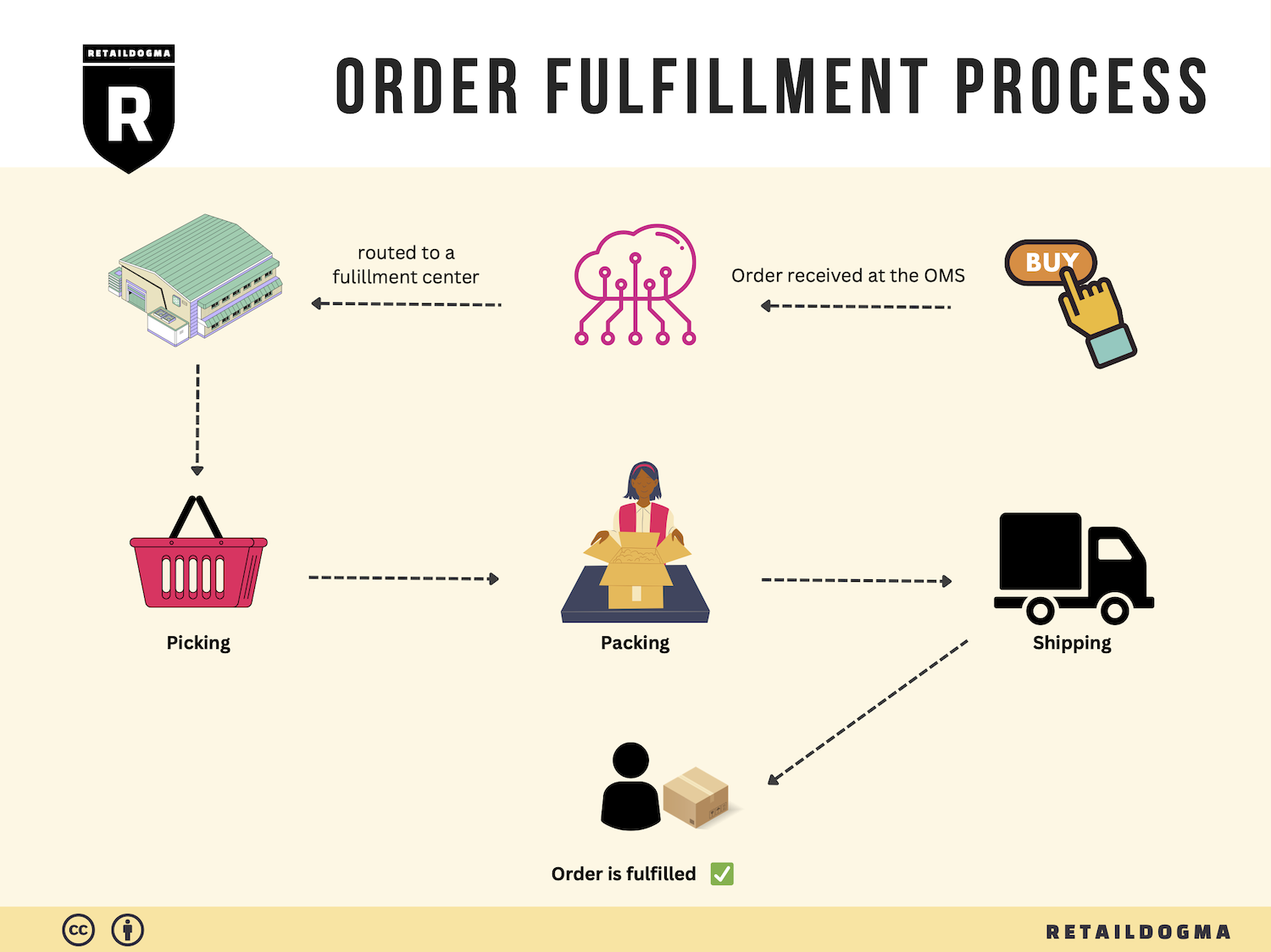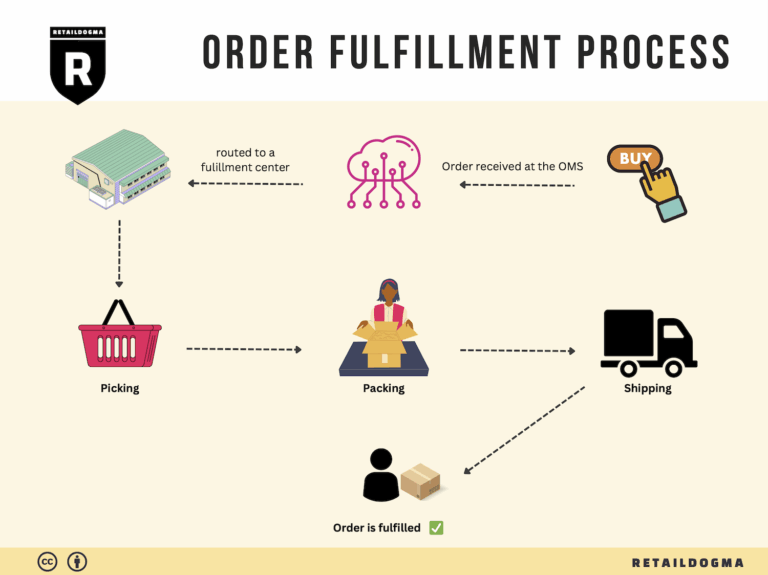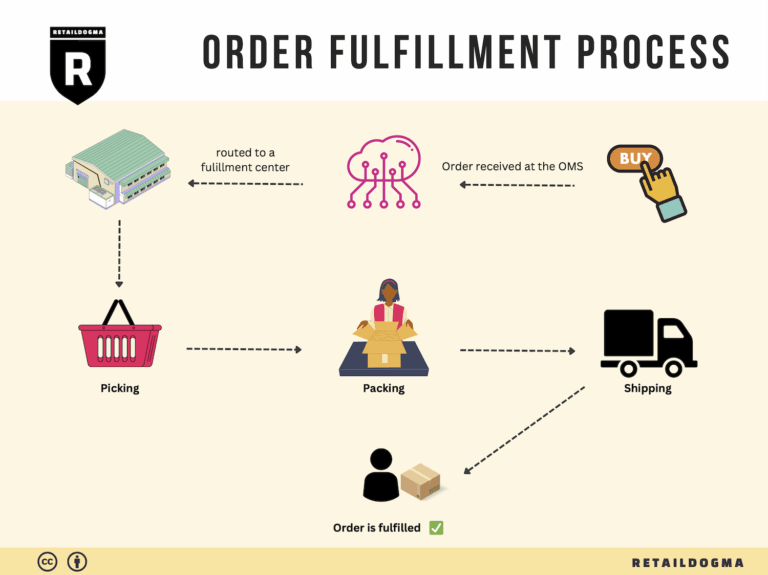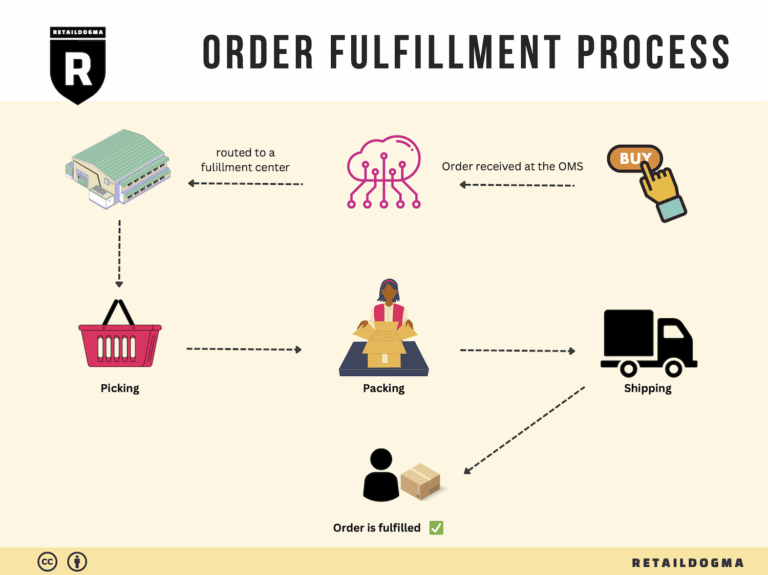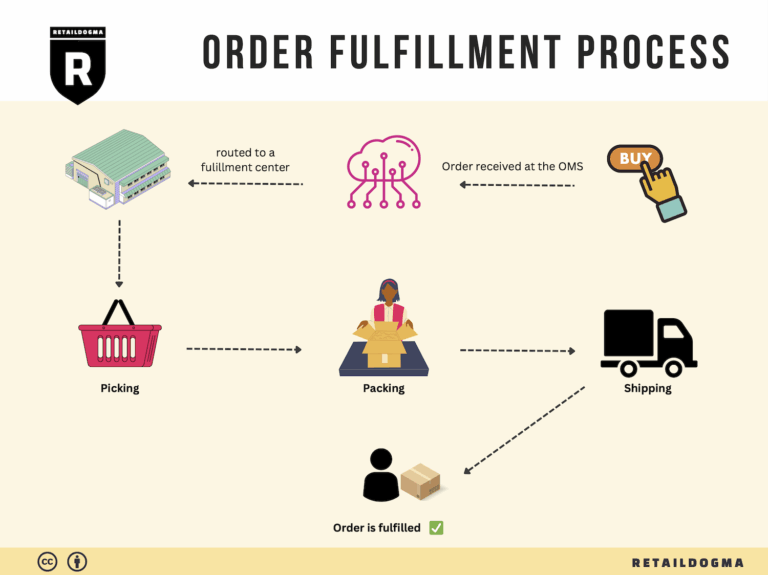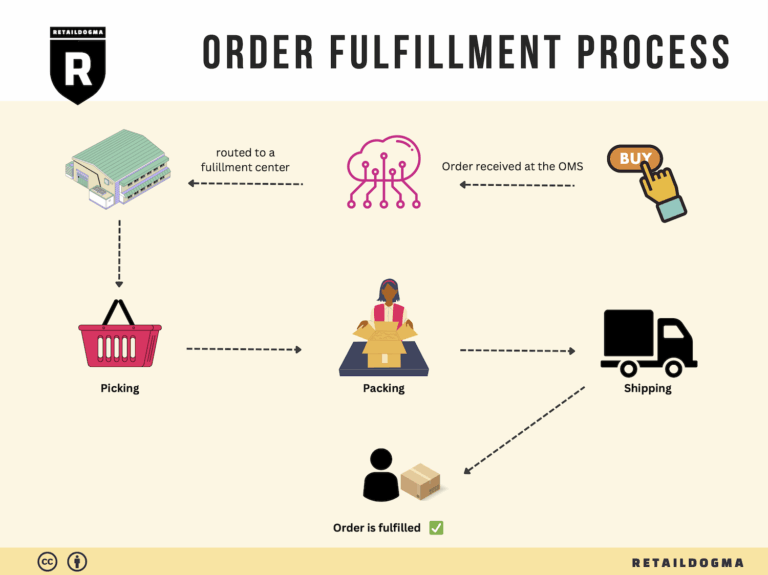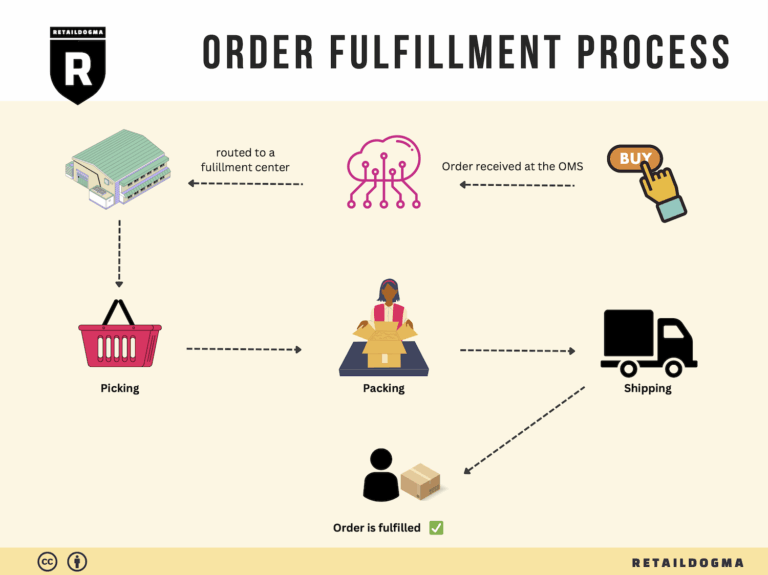How Order Fulfillment Works: A Step-by-Step Guide for Businesses
What is E-commerce Fulfillment? An Introduction for Growing Businesses
Navigating the Challenges of E-commerce Fulfillment
As an e-commerce business owner, you may find yourself grappling with the complexities of packing and shipping orders. The excitement of growing sales can quickly turn into stress as the demands of fulfilling orders pile up. Delayed shipments and packing errors can lead to frustrated customers, lost sales, and negative reviews—issues that can jeopardize your hard-earned reputation. This is where e-commerce fulfillment comes into play.
In its simplest form, fulfillment is the process of getting a product from your inventory to your customer’s doorstep. It encompasses everything from order processing and inventory management to shipping and returns. As your business expands, understanding the intricacies of fulfillment becomes crucial for maintaining customer satisfaction and driving growth.
This guide aims to demystify e-commerce fulfillment for growing businesses by covering essential topics that every entrepreneur should consider. We will explore various fulfillment models, such as Third-Party Logistics (3PL) and Fulfillment by Amazon (FBA), to help you determine which option aligns best with your business needs. Each model has its unique advantages and challenges, and understanding them is vital for making informed decisions.
Additionally, we will delve into the core services that fulfillment partners typically offer, including custom pick and pack solutions, real-time inventory management, product kitting and assembly, and returns processing. Knowing what services are available can empower you to choose a partner that not only meets your current needs but can also scale alongside your business.
Choosing the right fulfillment partner is a critical decision that can impact your operational efficiency and customer experience. We will provide practical tips on evaluating potential partners, considering factors like location, technology integrations, and their ability to handle seasonal demand spikes.

Finally, we will discuss pricing models for fulfillment services, helping you understand the cost implications of different options and how to budget effectively for logistics as you grow.
Our goal with this guide is to empower you to make smart, strategic decisions about your logistics operations. By mastering the fulfillment process, you can focus on what matters most: growing your business and delighting your customers.
What You’ll Learn In This Guide
- What is E-commerce Fulfillment? An Introduction for Growing Businesses
- The Order Fulfillment Process: From ‘Buy’ Button to Customer’s Door
- Comparing Fulfillment Models: In-House vs. 3PL vs. Dropshipping
- A Deep Dive into Amazon FBA: Pros, Cons, and Who It’s For
- Core Services Offered by Fulfillment Centers
- How to Choose a Fulfillment Partner: A 6-Point Checklist
- Understanding Fulfillment Pricing: A Breakdown of Common Fees
- Frequently Asked Questions (FAQs) about Fulfillment
- Conclusion: Is Outsourcing Fulfillment the Right Move for Your Business?
- Important Disclaimer
The Order Fulfillment Process: From ‘Buy’ Button to Customer’s Door
1. Receiving Inventory
The order fulfillment process begins with the Receiving Inventory stage. This step involves the acceptance of products from suppliers into your warehouse. Upon arrival, each item is checked against purchase orders to ensure accuracy in quantity and quality. This is where the concept of Stock Keeping Units (SKUs) comes into play. SKUs are unique identifiers for each product, allowing for precise tracking and inventory management.
Importance: Efficient receiving is crucial as it sets the foundation for your entire fulfillment operation. Any errors at this stage can lead to discrepancies down the line, affecting stock levels and customer orders. A systematic receiving process reduces the risk of human error and ensures that inventory is accurately logged into your system.
2. Warehouse Storage
Once inventory is received, the next step is Warehouse Storage. This involves placing products in designated areas within the warehouse for easy access. Proper organization often utilizes slotting—the strategic placement of items based on their sales velocity and size. Fast-moving items may be stored closer to the packing area, while slower-moving items can be placed further away.
Importance: Effective warehouse storage maximizes space and improves operational efficiency. A well-organized warehouse minimizes the time spent searching for products during the picking process, ultimately leading to faster order fulfillment. Additionally, real-time inventory tracking systems are essential at this stage to keep accurate records of stock levels and locations.
3. Order Picking
The Order Picking phase is where the actual fulfillment begins. Once a customer places an order, the system generates a pick list, which outlines the items needed for the order, along with their locations in the warehouse. Warehouse staff then retrieve these items, ensuring accuracy and efficiency.
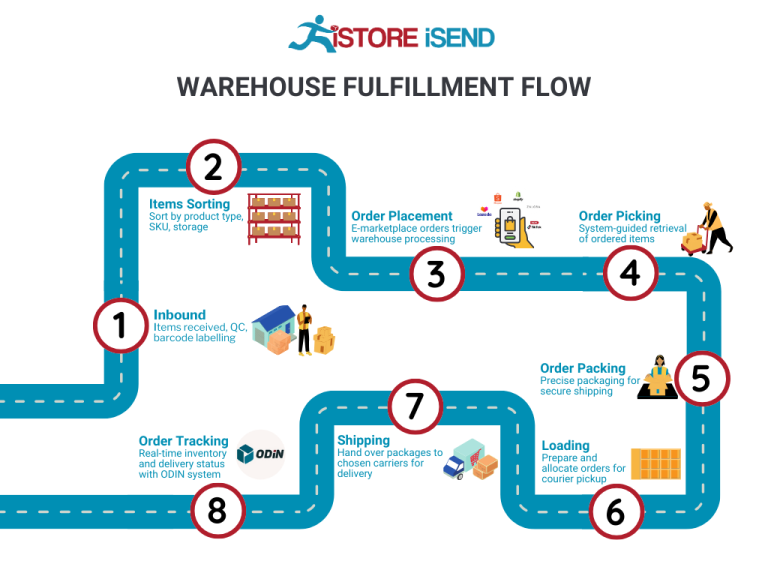
Importance: This step is critical because picking errors can lead to incorrect orders, resulting in customer dissatisfaction and increased return rates. Implementing technologies such as barcode scanners or mobile picking devices can streamline this process, enhancing accuracy and speed. The goal is to ensure that each order is picked precisely as requested, which strengthens customer trust and loyalty.
4. Order Packing
After items are picked, the next step is Order Packing. This process involves carefully packaging the items for shipment, ensuring they are secure and protected during transit. Packing materials—such as boxes, bubble wrap, and packing peanuts—should be selected based on the nature of the products being shipped. Packing slips, which include order details and return instructions, are also included in this stage.
Importance: Proper packing is vital for preventing damage during shipping, which can lead to costly returns and customer dissatisfaction. Moreover, an efficient packing process can enhance the overall customer experience. Using branded packaging can also reinforce your brand identity, making a lasting impression on customers when they receive their orders.
5. Shipping & Delivery
The final step in the order fulfillment process is Shipping & Delivery. Once an order is packed, it is labeled and handed over to a shipping carrier for delivery. This stage involves selecting the appropriate shipping method based on factors such as delivery speed, cost, and customer preferences. Tracking numbers are generated to allow customers to monitor their orders.
Importance: Timely and accurate shipping is crucial for customer satisfaction. Delays or errors at this stage can significantly harm your brand reputation. By using strategically located warehouses and optimizing shipping routes, businesses can reduce delivery times and shipping costs. Additionally, providing customers with real-time tracking information enhances transparency and trust, making for a positive post-purchase experience.
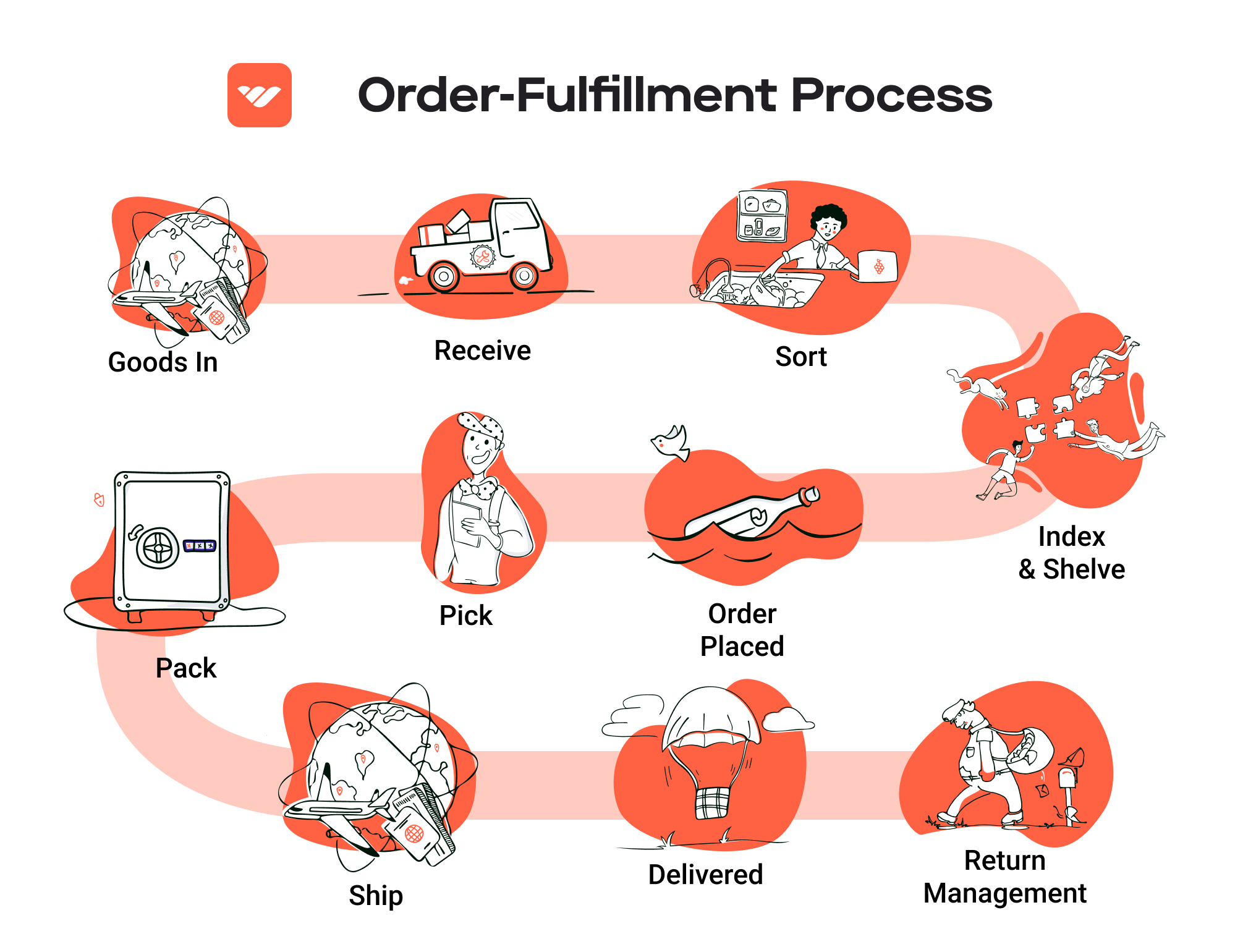
In conclusion, understanding and optimizing each step of the order fulfillment process is essential for scaling your e-commerce business. Each stage—from receiving inventory to shipping and delivery—plays a pivotal role in meeting customer expectations and enhancing overall operational efficiency. By implementing best practices and leveraging technology, businesses can ensure a seamless fulfillment experience that drives customer loyalty and growth.
Comparing Fulfillment Models: In-House vs. 3PL vs. Dropshipping
Fulfillment Model Comparison Table
| Model | Who Handles Inventory | Best For (Business Stage) | Key Advantage | Key Disadvantage |
|---|---|---|---|---|
| In-House Fulfillment | Business Owner/Staff | Startups to Established Businesses | Complete control over operations | High overhead costs and resource-intensive |
| Third-Party Logistics (3PL) | Third-Party Provider | Scaling Businesses and E-commerce | Scalable, cost-effective, and efficient | Less control over inventory and operations |
| Dropshipping | Supplier/Manufacturer | New Entrepreneurs and Niche Markets | Low startup costs and minimal risk | Lower margins and reliance on suppliers |
In-House Fulfillment
In-house fulfillment involves managing the entire logistics process within your own business. This model is characterized by the company owning its inventory, warehousing, and shipping processes. It is often favored by startups or established businesses looking for complete control over their fulfillment operations. The primary advantage of in-house fulfillment is the ability to maintain quality and operational oversight. Businesses can tailor their processes to fit their unique needs and customer expectations, leading to a personalized customer experience. However, this model comes with significant drawbacks, including high overhead costs associated with staffing, warehousing, and technology investments. It also requires a substantial commitment of time and resources to manage logistics effectively. As businesses scale, maintaining efficiency and accuracy can become challenging, particularly during peak seasons or unexpected demand spikes.
Third-Party Logistics (3PL)
Third-party logistics (3PL) providers offer a solution where businesses outsource their fulfillment needs to specialized logistics companies. This model is particularly beneficial for growing e-commerce businesses that require flexibility and scalability. A 3PL partner handles inventory storage, order processing, shipping, and returns management, allowing businesses to focus on core activities like marketing and product development. One of the key advantages of using a 3PL is the ability to scale operations quickly without the need for significant capital investment in infrastructure. Additionally, 3PL providers often have established relationships with carriers, which can lead to cost savings on shipping. However, the main disadvantage is the potential loss of control over inventory and the fulfillment process. Companies must rely on their 3PL partner’s efficiency and accuracy, which can impact customer satisfaction if not managed well. It’s crucial for businesses to choose a reputable 3PL that aligns with their operational needs and customer service expectations.
Dropshipping
Dropshipping is a fulfillment model where businesses sell products without holding inventory. Instead, when a customer places an order, the business purchases the item from a third-party supplier who then ships it directly to the customer. This model is particularly appealing to new entrepreneurs and those exploring niche markets due to its low startup costs and minimal risk. With dropshipping, businesses can offer a wide range of products without the burden of managing inventory or fulfillment logistics. However, the key disadvantages include lower profit margins and a heavy reliance on suppliers for inventory quality and shipping times. If a supplier faces delays or stock issues, it can directly affect the business’s reputation and customer satisfaction. Additionally, as the business grows, managing relationships with multiple suppliers can become complex and time-consuming. Therefore, while dropshipping provides an accessible entry point into e-commerce, it requires careful supplier selection and ongoing management to ensure a sustainable business model.
In summary, the choice between in-house fulfillment, 3PL, and dropshipping largely depends on your business stage, growth aspirations, and operational capabilities. Each model presents unique advantages and challenges that require careful consideration to align with your overall business strategy.
A Deep Dive into Amazon FBA: Pros, Cons, and Who It’s For
Understanding Fulfillment by Amazon (FBA)
Fulfillment by Amazon (FBA) is a service provided by Amazon that allows sellers to store their products in Amazon’s fulfillment centers. Amazon then takes care of storage, packaging, and shipping of these products directly to customers. This service not only enables sellers to leverage Amazon’s vast logistics network but also offers the potential for increased sales through access to Amazon Prime customers and enhanced visibility on the platform.
How FBA Works
-
Product Preparation and Shipping: Sellers begin by preparing their products according to Amazon’s guidelines, which include packaging and labeling requirements. Once ready, sellers ship their inventory to Amazon’s fulfillment centers.
-
Storage: Amazon stores the products in its warehouses. The inventory is managed through Amazon’s system, allowing sellers to track stock levels and sales.
-
Order Processing: When a customer places an order, Amazon picks the items from the warehouse, packs them, and ships them directly to the customer. This process is streamlined and designed for speed, often resulting in same-day or next-day delivery.
-
Customer Service: Amazon also handles customer service and returns for these orders, allowing sellers to focus on other aspects of their business.
-
Payment: Sellers receive payments for their sales, minus Amazon’s fees, which are deducted from the proceeds.
Pros of Amazon FBA
-
Prime Eligibility: One of the most significant advantages of using FBA is that products become eligible for Amazon Prime. This means that items can be shipped to Prime members with fast and free delivery options, significantly increasing the likelihood of sales.
-
Customer Trust: Leveraging Amazon’s reputation, sellers can build trust with customers. Many consumers are more likely to purchase from FBA sellers due to the perceived reliability and quality associated with Amazon’s services.
-
Multi-Channel Fulfillment: FBA isn’t limited to Amazon sales; sellers can also use FBA to fulfill orders from their own websites or other sales channels. This flexibility allows for a centralized logistics solution while reaching customers across various platforms.
-
Scalability: FBA allows businesses to scale quickly without the need for significant investment in warehousing and logistics. As sales increase, sellers can easily send more inventory to Amazon’s fulfillment centers.
-
Time Savings: With Amazon managing storage, packing, shipping, and customer service, sellers can focus on product development and marketing rather than logistics.
Cons of Amazon FBA
-
High Fees: While FBA can streamline logistics, it comes at a cost. Sellers are subject to various fees, including storage fees, fulfillment fees, and additional costs for long-term storage. These fees can add up, particularly for sellers with lower-margin products.
-
Strict Inventory Rules: Amazon has specific guidelines regarding inventory management, including quantity limits and performance metrics. Failure to adhere to these rules can lead to penalties, including account suspension.
-
Commingling Risks: FBA operates on a commingled inventory system, meaning that products from different sellers may be stored together. This can pose risks, such as receiving returns of products that are not yours or issues related to counterfeit goods affecting seller reputation.
-
Loss of Control: By outsourcing fulfillment to Amazon, sellers may lose some control over the customer experience. Issues such as packaging quality, shipping times, and handling of customer inquiries are all managed by Amazon.
-
Potential for Competition: Selling on Amazon means competing with other sellers, including Amazon itself. The risk of price wars and decreased margins can be significant, particularly in saturated markets.
Who is FBA Best For?
Fulfillment by Amazon is particularly beneficial for:
-
New Sellers: Entrepreneurs starting their e-commerce journey can leverage FBA to enter the market quickly without the complexities of logistics management.
-
Small to Medium-Sized Businesses: Businesses looking to scale their operations without investing heavily in warehousing and shipping can find FBA to be an effective solution.
-
Brands Seeking Visibility: Companies aiming to increase their visibility and sales on Amazon can benefit from the Prime eligibility and customer trust that come with FBA.
-
Multi-Channel Sellers: Businesses that sell across multiple platforms can utilize FBA to streamline their fulfillment processes, ensuring consistent service across channels.
-
Seasonal Sellers: Those with products that experience seasonal spikes can take advantage of FBA’s scalable solutions, making it easier to manage inventory during peak times.
In conclusion, while FBA offers numerous benefits that can enhance your e-commerce business, it’s essential to weigh these against the potential drawbacks. Understanding how FBA aligns with your business model and operational goals is crucial for making an informed decision.
Core Services Offered by Fulfillment Centers
Inventory Management & Warehousing
Inventory management and warehousing are foundational services provided by fulfillment centers, crucial for any e-commerce business aiming to scale efficiently. This service encompasses the storage, tracking, and management of products before they are sold. Fulfillment centers utilize advanced technology and software systems to maintain real-time visibility of inventory levels, ensuring that businesses know exactly what stock is available at any given time.
Benefits:
1. Real-Time Tracking: Accurate inventory tracking minimizes the risk of stockouts and overstock situations, enabling businesses to respond quickly to customer demands and market trends.
2. Climate-Controlled Storage: For products that require specific environmental conditions, fulfillment centers offer climate-controlled warehousing to maintain product integrity, especially for perishables or sensitive items.
3. Space Optimization: Utilizing a fulfillment center frees up valuable warehouse space for businesses, allowing them to focus on growth without the burden of managing physical storage.
By effectively managing inventory, businesses can enhance operational efficiency, reduce costs associated with excess inventory, and ultimately provide better service to customers.
Pick and Pack Services
Pick and pack services refer to the process of selecting ordered items from inventory and packaging them for shipment. This service is critical for fulfilling customer orders accurately and efficiently. Fulfillment centers employ skilled personnel and automated systems to ensure that each order is picked, packed, and shipped with precision.
Benefits:
1. Accuracy: High levels of accuracy in order fulfillment are paramount. Fulfillment centers often achieve order accuracy rates of 99.9%, significantly reducing the risk of errors that can lead to customer dissatisfaction and returns.
2. Speed: With streamlined processes and dedicated staff, fulfillment centers can significantly reduce the time it takes to process orders, leading to faster delivery times and improved customer satisfaction.
3. Scalability: As your business grows, fulfillment centers can easily scale their pick and pack services to handle increased order volumes, seasonal peaks, or promotional events without a hitch.
By leveraging expert pick and pack services, e-commerce businesses can enhance their operational capabilities, ensuring that customers receive their orders quickly and correctly.
Kitting and Assembly
Kitting and assembly services involve bundling multiple products into a single package or preparing products for sale in a specific configuration. This service is especially valuable for businesses that sell sets or promotional items, as it allows for customization and tailored offerings.
Benefits:
1. Customization: Kitting allows businesses to create unique product offerings that can differentiate them in a competitive marketplace. This can lead to increased sales and customer loyalty.
2. Efficiency: By outsourcing kitting and assembly to a fulfillment center, businesses can save time and reduce labor costs associated with in-house assembly processes.
3. Improved Presentation: Fulfillment centers often have the expertise and resources to package products attractively, enhancing the overall customer experience and perception of the brand.
With kitting and assembly services, e-commerce businesses can streamline their operations and create more appealing product offerings, ultimately driving sales and enhancing customer satisfaction.
Returns Management (Reverse Logistics)
Returns management, or reverse logistics, is the process of handling returned items efficiently. This service is crucial for maintaining customer relationships and managing inventory effectively. Fulfillment centers specialize in processing returns, inspecting items, restocking inventory, and managing customer communications.
Benefits:
1. Customer Satisfaction: A hassle-free return process fosters trust and confidence in the brand, encouraging repeat purchases. Fulfillment centers handle returns swiftly, minimizing the inconvenience for customers.
2. Inventory Control: Efficient returns management helps businesses quickly reintegrate returned products into their inventory, reducing losses and improving stock accuracy.
3. Data Insights: Fulfillment centers can provide valuable insights into return trends, helping businesses identify issues with products or customer expectations, thus allowing for informed decision-making.
By implementing robust returns management services, e-commerce businesses can enhance customer loyalty, reduce operational costs associated with handling returns, and ultimately improve their bottom line.
In conclusion, partnering with a fulfillment center for these core services not only streamlines e-commerce operations but also enables businesses to focus on strategic growth initiatives while ensuring customer satisfaction remains a top priority.
How to Choose a Fulfillment Partner: A 6-Point Checklist
Location & Warehouse Network
Why It Matters:
The geographical location of your fulfillment partner’s warehouses can significantly impact shipping times and costs. A partner with strategically located facilities can help minimize transit times to your customers, which is critical for customer satisfaction and retention.
Questions to Ask:
– Where are your warehouses located? How do these locations benefit my shipping needs?
– What percentage of my customer base can you reach within a specific delivery timeframe (e.g., 1-3 days)?
– Do you have the capability to open additional warehouses if my business scales or requires more geographic coverage?
Technology & Integrations
Why It Matters:
In today’s digital marketplace, seamless technology integration is essential for efficient operations. A partner that offers robust technology solutions can streamline order processing, inventory management, and provide real-time data analytics, which are vital for making informed business decisions.
Questions to Ask:
– What technology platforms do you use for inventory management and order processing?
– Can your systems integrate with my existing e-commerce platform (e.g., Shopify, WooCommerce)?
– How do you handle data security and compliance, especially concerning customer information?
Specializations (e.g., Cold Storage, Oversized Items)
Why It Matters:
Different businesses have unique product requirements. If your products require special handling—such as temperature control for perishable goods or specialized packaging for oversized items—partnering with a fulfillment provider that has the necessary capabilities is crucial for maintaining product integrity and compliance.
Questions to Ask:
– Do you have specialized facilities for specific product types (e.g., cold storage, hazardous materials)?
– What experience do you have in handling products similar to mine?
– Can you provide case studies or references from clients with similar needs?
Scalability & Capacity
Why It Matters:
Your fulfillment partner should be able to grow with your business. Whether you experience seasonal spikes in demand or rapid growth, your partner must have the capacity to manage increased order volume without compromising service quality.
Questions to Ask:
– What measures do you have in place to scale operations during peak seasons or promotional events?
– How do you handle unexpected surges in order volume?
– Can you provide metrics on your average order processing times and capacity limits?
Pricing and Contracts
Why It Matters:
Understanding the pricing structure and contract terms is essential for budgeting and financial planning. A transparent pricing model can help you avoid hidden fees and ensure that the partnership is financially viable in the long run.
Questions to Ask:
– Can you provide a detailed breakdown of your pricing structure (e.g., storage fees, pick and pack fees, shipping costs)?
– Are there any hidden fees I should be aware of?
– What are the terms of the contract, and is there flexibility in case my needs change?
Customer Support & Reviews
Why It Matters:
Reliable customer support is vital for addressing issues promptly and maintaining operational efficiency. Additionally, researching customer reviews can provide insights into the partner’s reliability and quality of service.
Questions to Ask:
– What customer support channels do you offer (e.g., phone, email, chat)?
– What is your average response time to support inquiries?
– Can you provide references or case studies from current clients? What do they say about your service quality?
Conclusion
Choosing the right fulfillment partner is a critical decision that can significantly impact your business operations and customer satisfaction. By using this checklist as a guide, you can systematically evaluate potential partners and ensure they align with your business goals. Remember to prioritize open communication and transparency during the selection process, as these are indicators of a successful long-term partnership.
Understanding Fulfillment Pricing: A Breakdown of Common Fees
Initial Setup Fees
Initial setup fees are typically charged when a business first engages with a fulfillment provider. These fees cover the costs associated with onboarding, including the integration of your e-commerce platform with the fulfillment system, training, and the establishment of processes tailored to your business needs. The calculation of these fees can vary significantly based on the complexity of your operations and the technology required. For example, if you need custom software integration or specialized reporting tools, expect higher fees. It’s crucial to discuss what services are included in the setup fee and ensure there are no hidden costs.
Receiving Fees
Receiving fees are incurred when your products are delivered to the fulfillment center. These fees cover the labor and processes involved in unloading, inspecting, and properly storing your products. The calculation of receiving fees can be based on various factors, such as the volume of goods being received, the number of individual items, or the specific handling requirements (e.g., fragile items). Some fulfillment centers may charge a flat fee per pallet or a per-item fee, while others might incorporate these costs into a broader service fee. Understanding how these fees are structured is essential, particularly if you have fluctuating inventory levels or seasonal spikes in product shipments.
Storage Fees (per pallet/bin)
Storage fees apply to the space your inventory occupies within the fulfillment center. These fees are typically calculated on a per-pallet or per-bin basis, depending on how your products are stored. For example, if you are using pallet storage, you might be charged a monthly fee for each pallet your products occupy. Conversely, if your items are stored in bins, the fee may be calculated based on the number of bins used. It’s important to consider that storage fees can increase during peak seasons when demand for space is higher. To optimize storage costs, regularly evaluate your inventory turnover rates and adjust your stock levels accordingly.
Pick & Pack Fees (per item/order)
Pick and pack fees are charged for the labor involved in retrieving items from storage and preparing them for shipment. These fees can be structured as a flat rate per order or on a per-item basis. For instance, if your fulfillment provider charges $1 per item and you have an order of five items, your pick and pack fee would be $5. Some providers may also offer tiered pricing based on order volume, which can lead to significant savings as your business scales. Additionally, if your products require special packaging or kitting, be aware that these services may incur additional fees. Understanding the specifics of these fees can help you manage costs effectively as your order volumes fluctuate.
Shipping Fees
Shipping fees are one of the most variable costs in fulfillment pricing and can significantly impact your overall logistics expenses. These fees are determined by several factors, including the shipping method chosen (e.g., standard, expedited), the weight and dimensions of the packages, and the destination. Many fulfillment providers negotiate rates with carriers and pass those savings on to you, but it’s essential to clarify how these fees are calculated. Some providers may offer flat-rate shipping options for certain order sizes, while others might charge based on actual shipping costs. It’s advisable to compare shipping rates across different providers and consider their shipping zone strategies, as strategically located fulfillment centers can reduce shipping costs and delivery times.
Tips for Getting an Accurate Quote
-
Provide Detailed Information: When seeking quotes, provide potential fulfillment partners with as much information as possible about your products, order volumes, and specific needs. This includes dimensions, weight, packaging requirements, and expected seasonality.
-
Ask for a Breakdown of Fees: Request a detailed breakdown of all potential fees involved in the fulfillment process. Understanding each component will help you avoid unexpected costs down the line.
-
Negotiate Terms: Don’t hesitate to negotiate terms, especially if you have a growing business. Many fulfillment providers are willing to adjust their pricing structures for long-term partnerships.
-
Consider the Whole Package: Look beyond just pricing; consider the quality of service, technology integration, and customer support. Sometimes paying slightly more can lead to better overall satisfaction and efficiency.
-
Review Regularly: As your business scales, regularly review your fulfillment pricing and service levels. Changes in order volume, product lines, or market conditions may necessitate a reevaluation of your fulfillment strategy.
By taking the time to understand these common fees and how they are calculated, you can make informed decisions that align with your business goals and budget, ultimately leading to a more efficient and cost-effective fulfillment operation.
Frequently Asked Questions (FAQs) about Fulfillment
1. What is IDS Fulfillment?
IDS Fulfillment is a third-party logistics (3PL) provider specializing in e-commerce order fulfillment. They offer tailored solutions that include inventory management, custom pick and pack services, product kitting, assembly, returns management, and technology integrations to streamline logistics and enhance customer satisfaction.
2. How does IDS Fulfillment ensure order accuracy?
IDS Fulfillment maintains a 99.9% order accuracy rate through meticulous order processing practices and advanced inventory management systems. Their focus on precision helps minimize errors, ensuring that customers receive the correct items promptly.
3. What is the difference between a warehouse and a fulfillment center?
A warehouse primarily serves as a storage facility for goods, focusing on inventory management and bulk storage. In contrast, a fulfillment center specializes in processing orders, including picking, packing, and shipping products directly to customers. Fulfillment centers are designed for speed and efficiency in order processing.
4. What is a 3PL, and how does it benefit my business?
A third-party logistics (3PL) provider offers outsourced logistics services, including transportation, warehousing, and fulfillment. Partnering with a 3PL can help businesses scale operations, reduce costs, and improve delivery times, allowing owners to focus on core business activities while leveraging the expertise of logistics professionals.
5. How much do fulfillment services cost?
Fulfillment service costs vary based on factors such as order volume, storage needs, and specific services required (e.g., kitting, returns management). Typically, costs include a per-order fee, storage fees, and additional charges for value-added services. It’s advisable to request a customized quote based on your business’s unique needs.
6. Can IDS Fulfillment handle seasonal demand spikes?
Yes, IDS Fulfillment is equipped to manage seasonal demand fluctuations and unexpected growth. Their scalable solutions and strategically located facilities allow for rapid adjustments in operations to meet increased order volumes during peak seasons or promotions.
7. How do I integrate my e-commerce platform with IDS Fulfillment?
IDS Fulfillment offers seamless technology integrations with various e-commerce platforms. This ensures that inventory levels, order processing, and shipping information are synchronized in real-time, allowing for efficient operations and improved customer service.
8. What is the process for returns management?
IDS Fulfillment provides a hassle-free returns management service, which includes receiving returned items, inspecting their condition, and processing refunds or exchanges as per your return policy. This service helps maintain positive customer relationships and streamline the returns process.
9. How does IDS Fulfillment ensure product safety during storage?
IDS Fulfillment utilizes climate-controlled storage facilities that meet FDA regulations to maintain product integrity and safety. They employ strict inventory management practices to monitor and safeguard products, ensuring they remain in optimal condition until shipped.
10. What are the benefits of using IDS Fulfillment for my e-commerce business?
Utilizing IDS Fulfillment allows e-commerce businesses to benefit from expert logistics management, improved order accuracy, faster shipping times, and the ability to scale operations efficiently. By outsourcing fulfillment, businesses can enhance customer satisfaction, reduce operational costs, and focus on growth and strategy.
Conclusion: Is Outsourcing Fulfillment the Right Move for Your Business?
Evaluating the Benefits of Outsourcing Fulfillment
Outsourcing your fulfillment can be a game-changer for your e-commerce business, enabling you to save time, scale operations, and leverage specialized expertise. By partnering with a fulfillment service, you can redirect your focus from logistics to core business functions, such as product development and marketing. This shift not only enhances productivity but also fosters innovation within your team.
One of the most significant advantages of utilizing a fulfillment service is scalability. As your business grows, so do your logistics needs. A proficient fulfillment partner can seamlessly accommodate spikes in demand, whether due to seasonal sales or product launches, ensuring that you meet customer expectations without the headaches of managing logistics in-house. This agility is vital in today’s fast-paced e-commerce landscape, where customer satisfaction hinges on timely and accurate deliveries.
Moreover, working with experts in fulfillment allows you to tap into best practices and advanced technologies that can optimize your operations. These partners typically offer real-time inventory management, strategic shipping solutions, and tailored services that align with your unique business goals. Their experience can help you avoid common pitfalls, enhance order accuracy, and ultimately build customer trust.
However, the success of outsourcing fulfillment hinges on selecting the right partner. It’s crucial to evaluate potential fulfillment providers based on their capabilities, reliability, and alignment with your business needs.
Call to Action
To determine whether outsourcing fulfillment is the right move for your business, conduct a thorough audit of your current shipping processes. Identify inefficiencies, bottlenecks, and areas where a fulfillment partner could provide significant benefits. Taking this proactive step will guide you toward making an informed decision that supports your growth and enhances your customer experience.
Important Disclaimer
⚠️ Important Disclaimer
The information in this guide is for educational purposes. Fulfillment services, pricing, and platform features change frequently. Always conduct your own due diligence and consult with providers directly before making business decisions.
